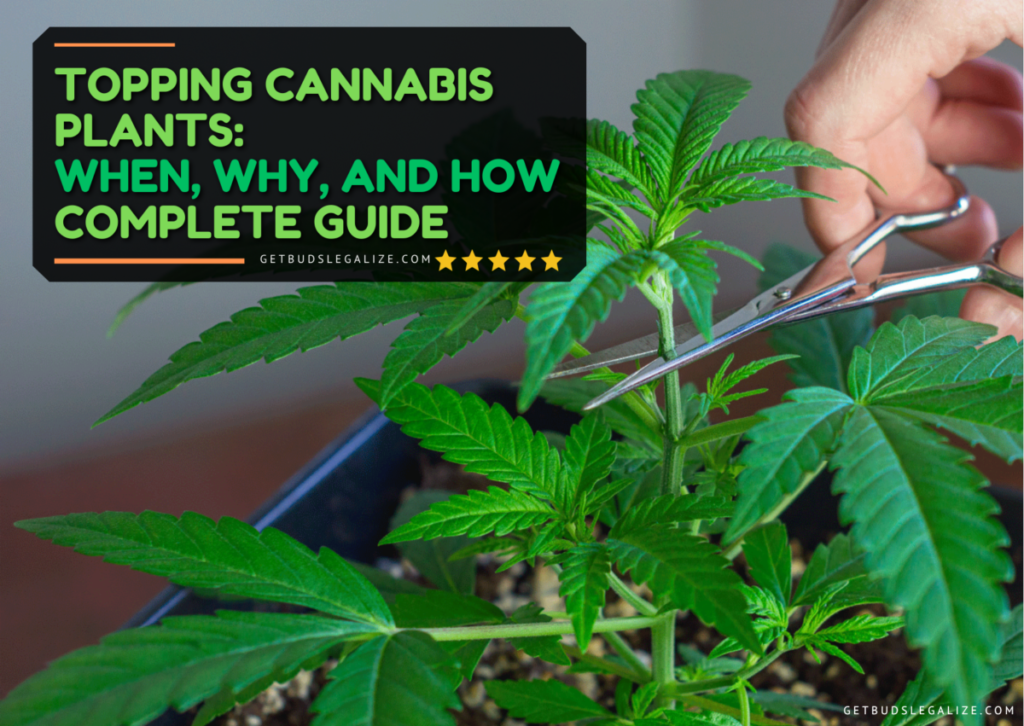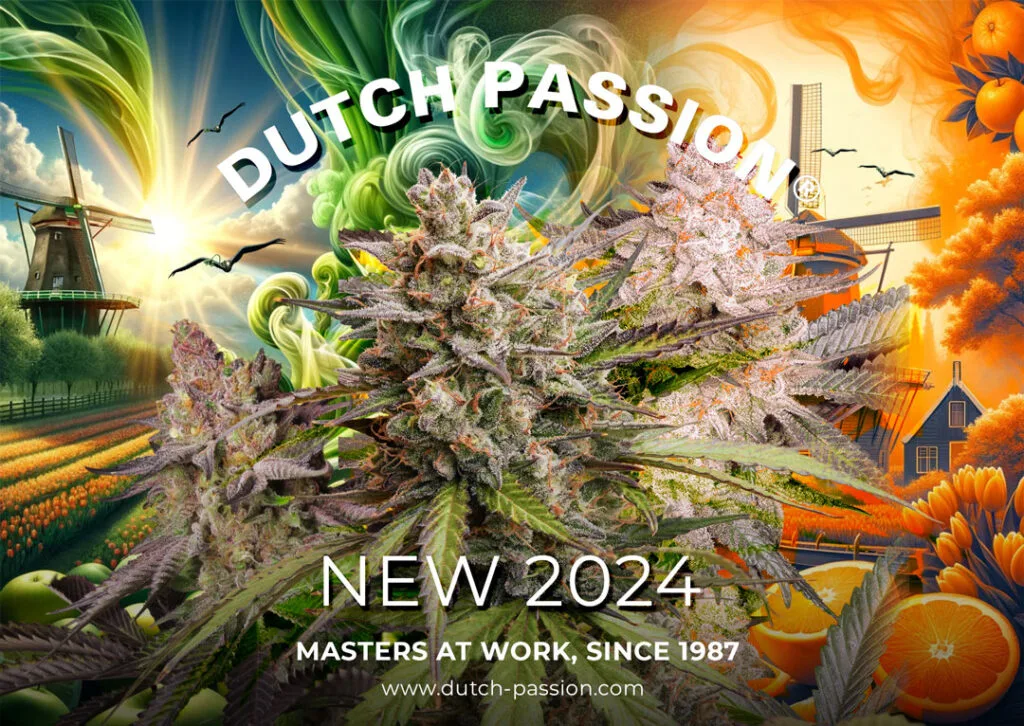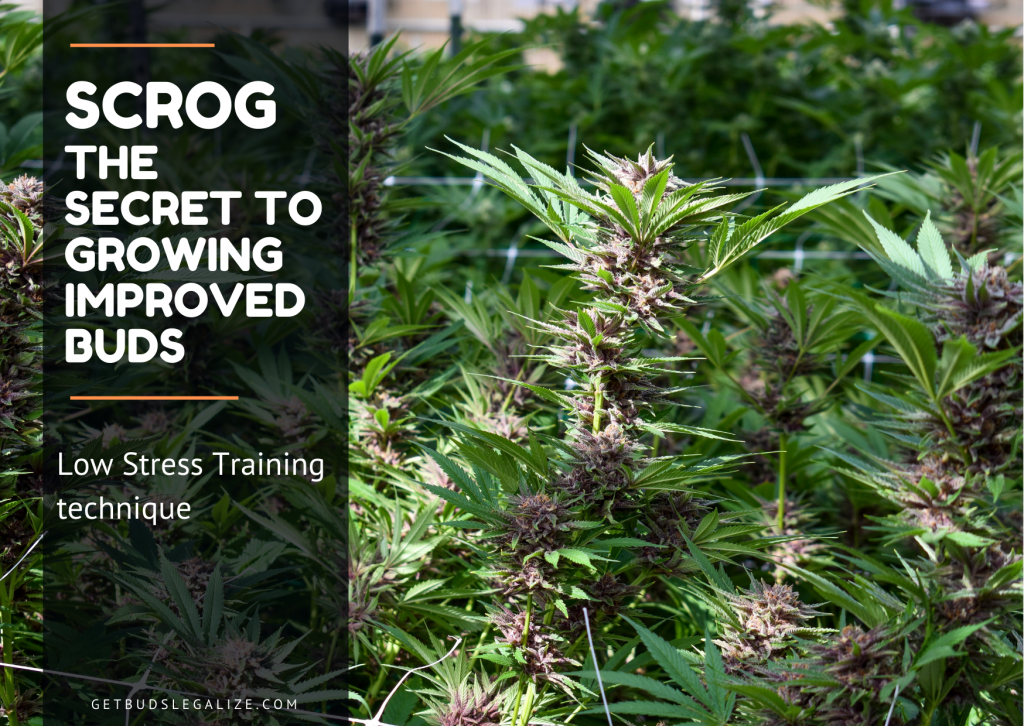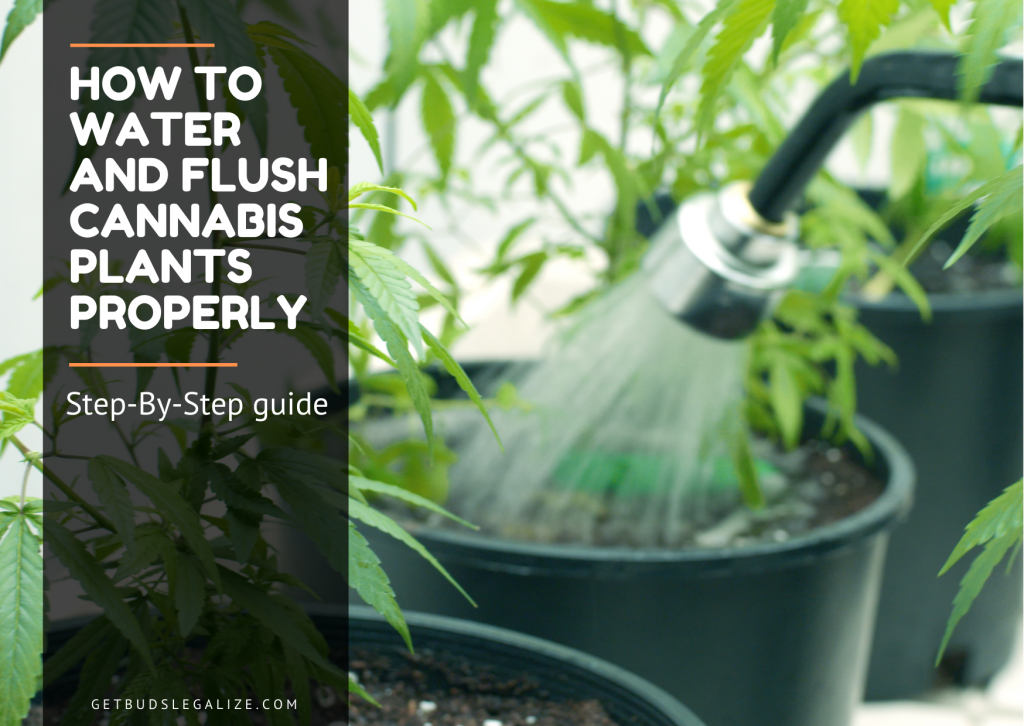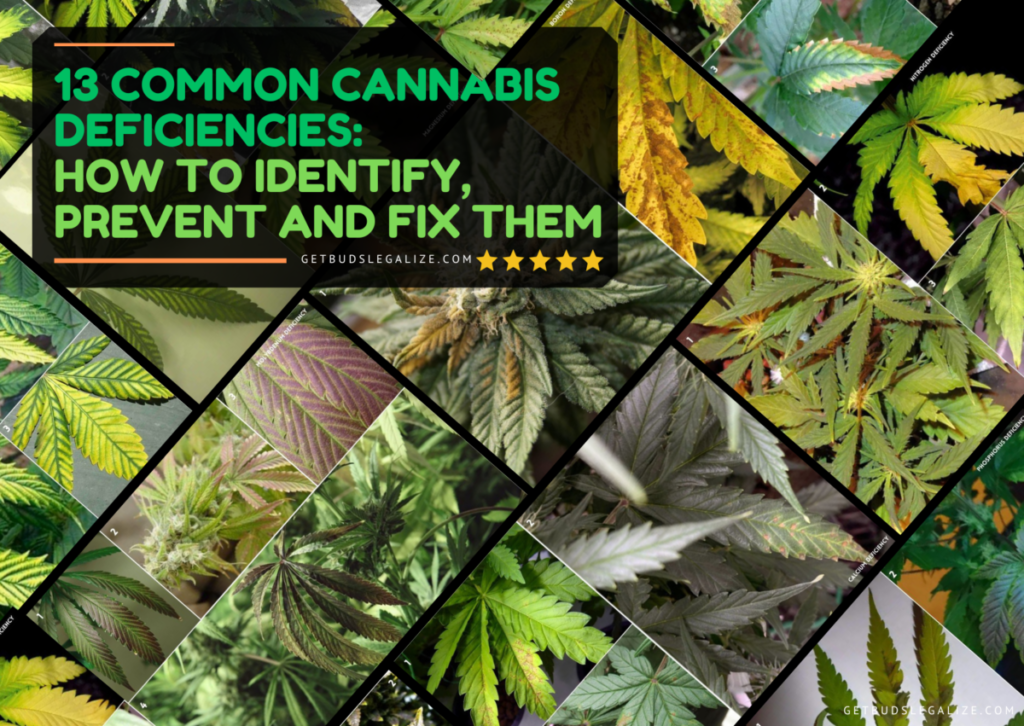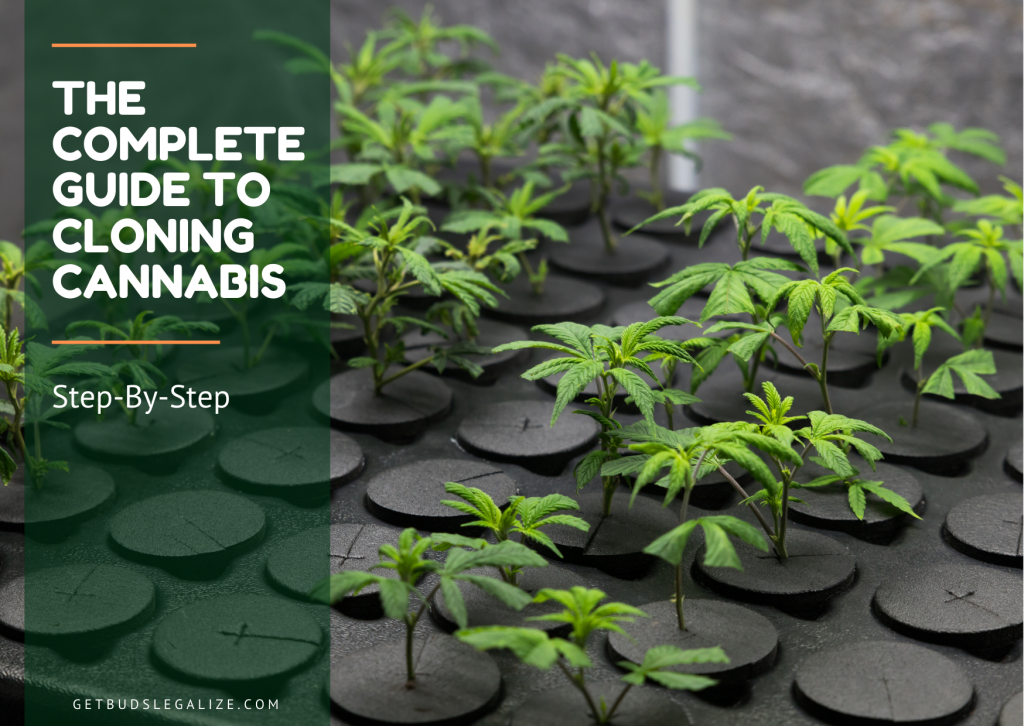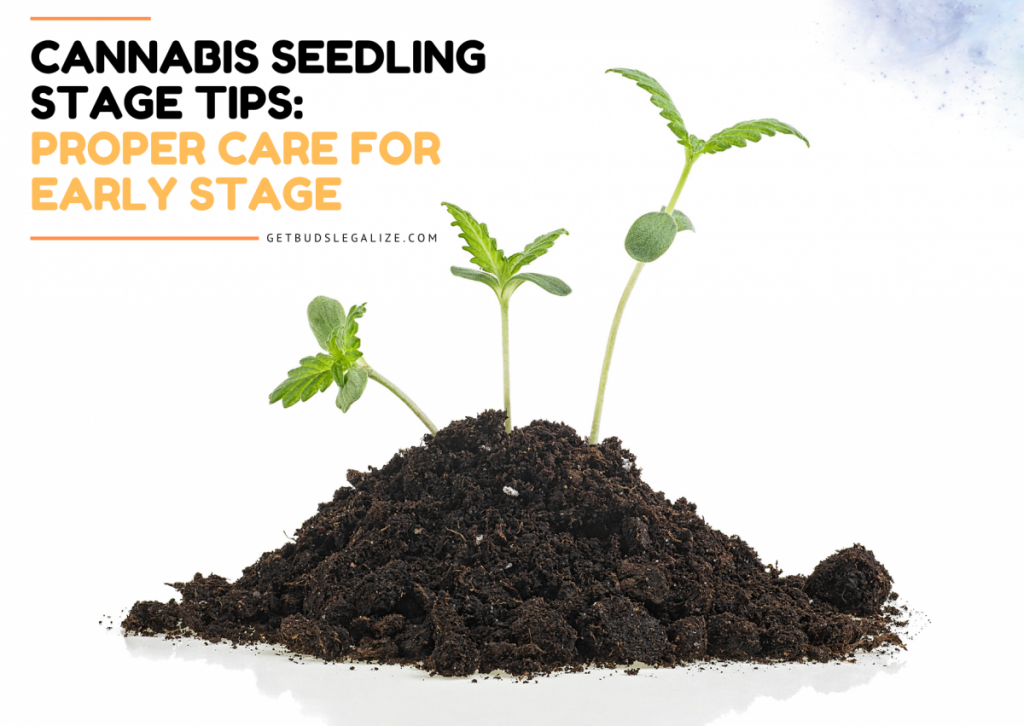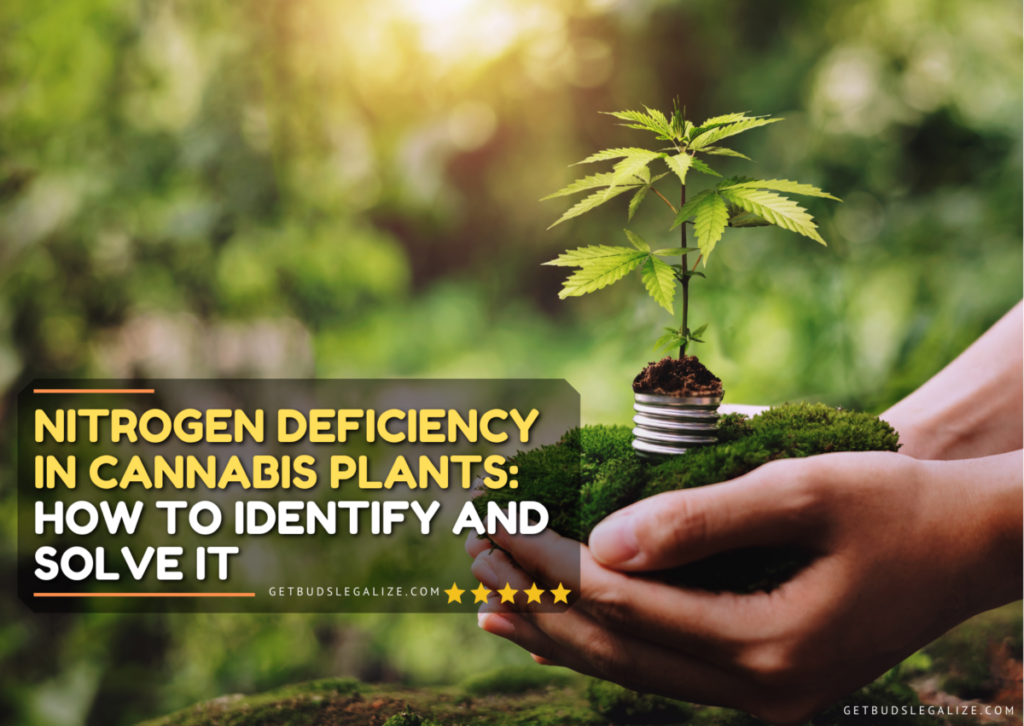Topping Cannabis Plants: When, Why, and How
If you are growing cannabis for personal or commercial use, you might have heard of a technique called “topping”. Topping is a form of pruning that involves cutting off the main stem of a cannabis plant, usually just above a node where two branches emerge. This stimulates the growth of multiple main colas (flowering sites) instead of one, resulting in a bushier and more productive plant.
Topping can also help control the height and shape of your cannabis plants, which can be useful if you have limited space or want to create a canopy of even buds.
But topping is not a simple or risk-free process. It requires careful timing, proper technique, and some trade-offs. In this blog post, we will explain what topping means, why you might want to do it, when and how to do it, and what to consider before you decide to top your cannabis plants. We will also compare topping with another pruning method called fimming, and give you our bottom line on whether topping is worth it or not.
What Does "Topping Cannabis" Mean?
Topping cannabis means cutting off the top part of the main stem of a cannabis plant, usually just above a node where two branches emerge. This creates two new main stems that grow outwards from the cut site. Each of these stems can produce a main cola (a cluster of buds) at the top, as well as several side branches that can also produce buds.
By topping the cannabis plant, you essentially double the number of main colas it can produce.
Topping is different from pinching or bending the main stem, which are other ways of manipulating the growth of your cannabis plant. Pinching involves squeezing the main stem between your fingers to damage its inner tissues and slow down its vertical growth. Bending involves gently bending the main stem to one side to expose more of the lower branches to light.
Both of these methods aim to create a more even canopy of buds without cutting off any part of the plant.
Why Should I Top My Cannabis Plants?

The main reason why growers top their cannabis plants is to increase their yield. By creating more main colas, you can potentially harvest more buds from each plant. This is especially beneficial if you are growing indoors with limited space or outdoors with legal restrictions on the number of plants you can grow.
Topping can also help you optimize the use of your light source, as more buds will be exposed to direct light instead of being shaded by the single main cola.
Another reason why growers top their cannabis plants is to control their height and shape. Some cannabis strains can grow very tall and stretchy, especially during the flowering stage. This can pose problems if you have limited vertical space or if you want to keep your plants discreet.
By topping your cannabis plants early in their vegetative stage, you can prevent them from growing too tall and encourage them to grow more horizontally. This can also help you create a more uniform canopy of buds that receive equal amounts of light and air circulation.
When Is the Best Time to Top My Cannabis Plants?
The ideal time to top your cannabis plants is during their vegetative stage when they are growing rapidly and producing new foliage. This allows them to heal from the stress and branch out before they switch to the flowering stage.
The exact timing of topping depends on various factors, such as the strain, the size, and the health of your plant. As a general rule, you should wait until your plant has at least 4-6 nodes on its main stem before you top it. This ensures that your plant has enough energy and resources to cope with the pruning and develop new stems.
You should also avoid topping your plant too close to the flowering stage, as this can reduce its recovery time and affect its bud production.
What Are the Benefits and Drawbacks of Topping?
Cannabis topping is a common technique for increasing the yield and quality of your plants. However, cannabis topping also has some drawbacks and risks that you should be aware of before trying it. Here are some things to consider before running it on your plants:
Potential Benefits of topping cannabis plants:
- Increasing the number of colas and buds per plant.
- increase yields.
- Creating a more even canopy that receives more light and airflow.
- Reducing the risk of mold and pests by improving ventilation.
- Controlling the height and shape of the plant to fit your growing space.
- Encouraging lateral growth and bushiness.
- Enhancing the potency and flavor of the buds by diverting more energy to them.
Potential Drawbacks of topping cannabis plants:
- Stressing the plant and slowing down its growth temporarily.
- Reducing the size and density of the individual buds.
- Extending the flowering time of the plant.
- Increasing the nutrient and water requirements of the plant.
- Exposing more branches to potential damage or disease.
How Do I Top My Cannabis Plants Correctly?
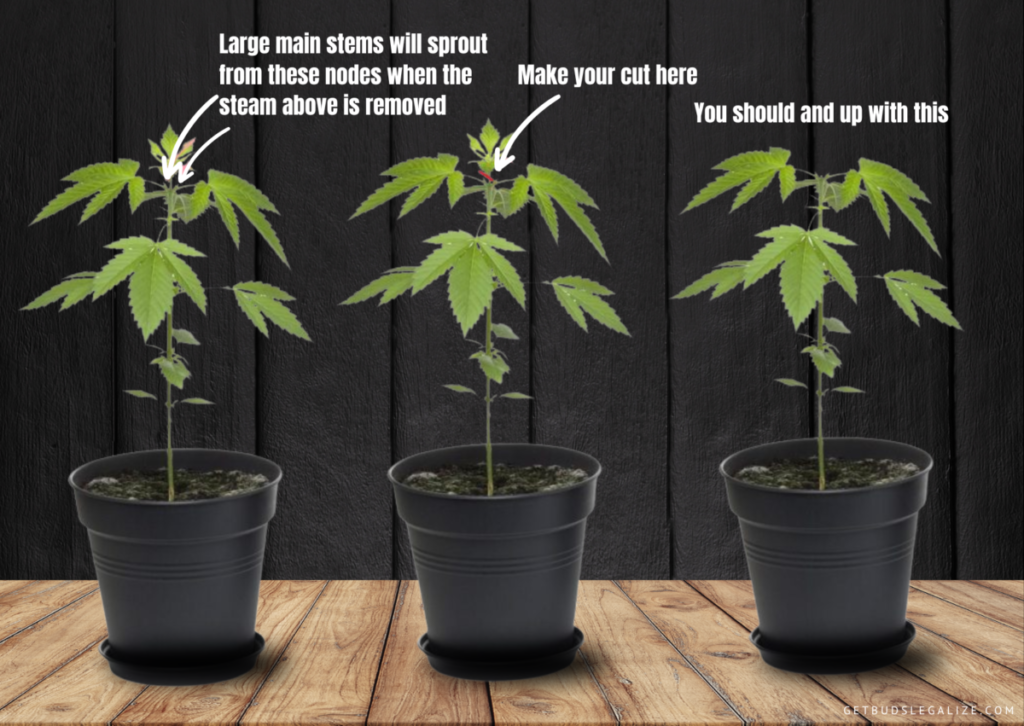
Topping cannabis plants is not very difficult, but it requires some precision and care. Here are the basic steps on how to top your plants correctly:
- Choose a healthy and vigorous cannabis plant that has at least 4-6 nodes (sets of leaves) on its main stem.
- Identify the node where you want to make the cut. It should be at least 2-3 nodes below the top of the plant, leaving enough room for new growth.
- Use a sharp and sterile pair of scissors or pruning shears to cut off the main stem just above the node, leaving about 1/4 inch (0.6 cm) of stem above it.
- Dispose of the cut-off part or use it for cloning if you wish.
- Apply some organic antiseptic such as honey or aloe vera gel to the cut site to prevent infection and promote healing.
- Monitor your plant for signs of stress or recovery. It may take a few days for your plant to adjust to the topping and start growing new stems.
How Do I Care for My Topped Cannabis Plants?
Here are some tips to help your plants recover and thrive after topping:
1• Keep your plants hydrated but not soggy. Water them when the top inch of the soil feels dry to the touch, and make sure the drainage is adequate.
2• Provide your plants with a suitable nutrient solution that promotes vegetative growth. Use a fertilizer that has a high nitrogen content and a low phosphorus content, and follow the manufacturer’s instructions.
3• Set the right light cycle for your plants depending on their stage of growth. For vegetative growth, you can use 18 hours of light and 6 hours of darkness, or 24 hours of light. For flowering, you need to switch to 12 hours of light and 12 hours of darkness.
4• Control the temperature and humidity levels in your grow room or tent. The ideal range for cannabis plants is between 20 and 28 degrees Celsius and between 40 and 60 percent relative humidity. You can use fans, heaters, humidifiers, or dehumidifiers to adjust these factors as needed.
5• Trim or train your plants further if necessary to improve their shape and yield. You can remove any dead or damaged leaves or branches, or use techniques like low-stress training (LST), super cropping, or scrogging to manipulate your plants’ growth.
How Many Times Can I Top My Cannabis Plants?
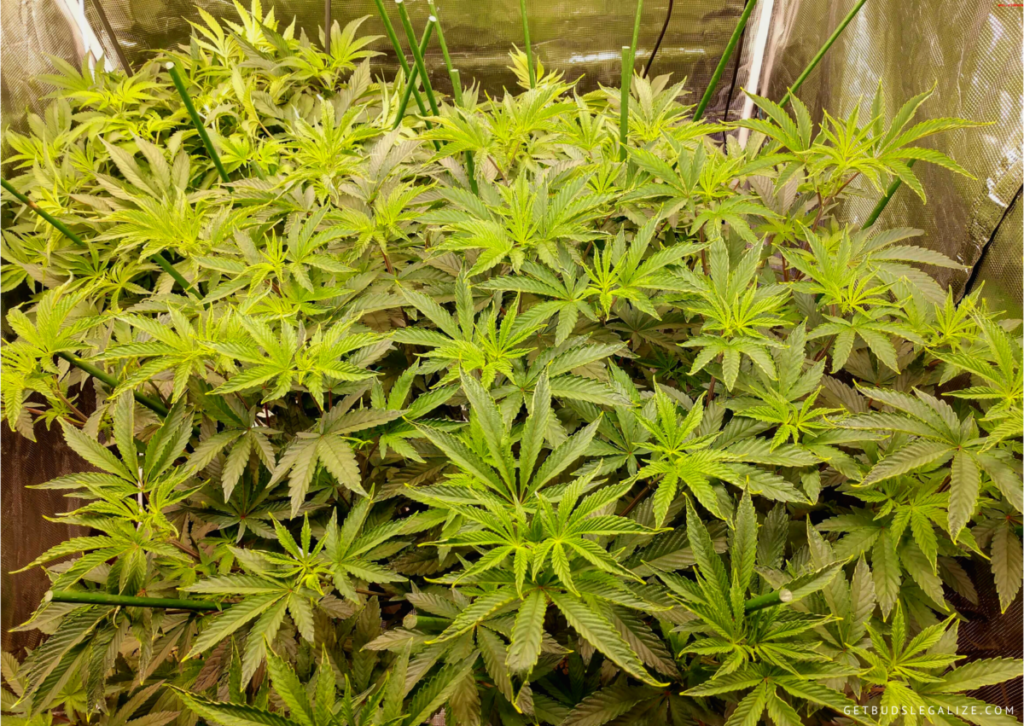
There are several factors to take into consideration, such as the strain, the size, the health, and the stage of the plant. Generally speaking, most cannabis plants can be topped once or twice during the vegetative phase, when they have at least 4-6 nodes. Topping more than twice can cause excessive stress and stunt the growth of the plant. Topping during the flowering is not recommended, as it can reduce the quality and quantity of the buds.
Some strains are more resilient and can handle more topping than others. For example, indica-dominant strains tend to be bushier and more compact, so they can benefit from more topping to create a wider and flatter canopy. Sativa-dominant strains tend to be taller and more stretchy, so they may not need as much topping to achieve a good yield. Hybrid strains may vary depending on their genetics and characteristics.
The size of the plant also matters when deciding how many times to top it. Larger plants have more energy and resources to recover from topping, so they can handle more cuts than smaller plants. However, larger plants also need more space and light to grow well, so topping them too much may cause overcrowding and shading issues. Smaller plants may not have enough nodes to top multiple times, so they may be better off with just one cut or none at all.
The health of the plant is another factor to consider when topping it. Healthy plants can cope with stress better than unhealthy ones, so they can tolerate more topping without suffering from problems. Unhealthy plants may already be weak or damaged, so topping them may worsen their condition and affect their growth and yield. Therefore, it is advisable to only top healthy plants that show no signs of pests, diseases, nutrient deficiencies, or environmental stress.
The stage of the plant is also important when topping it. Topping should only be done during the vegetative phase when the plant is actively growing new stems and leaves. This is because topping stimulates the production of hormones that promote branching and bushiness, which are desirable traits for a vegetative plant.
Topping during the flowering can have negative effects on the plant, such as reducing its bud size and potency, delaying its maturation, or triggering hermaphroditism.
How Does Topping Affect the Flowering Time and Harvest Date?
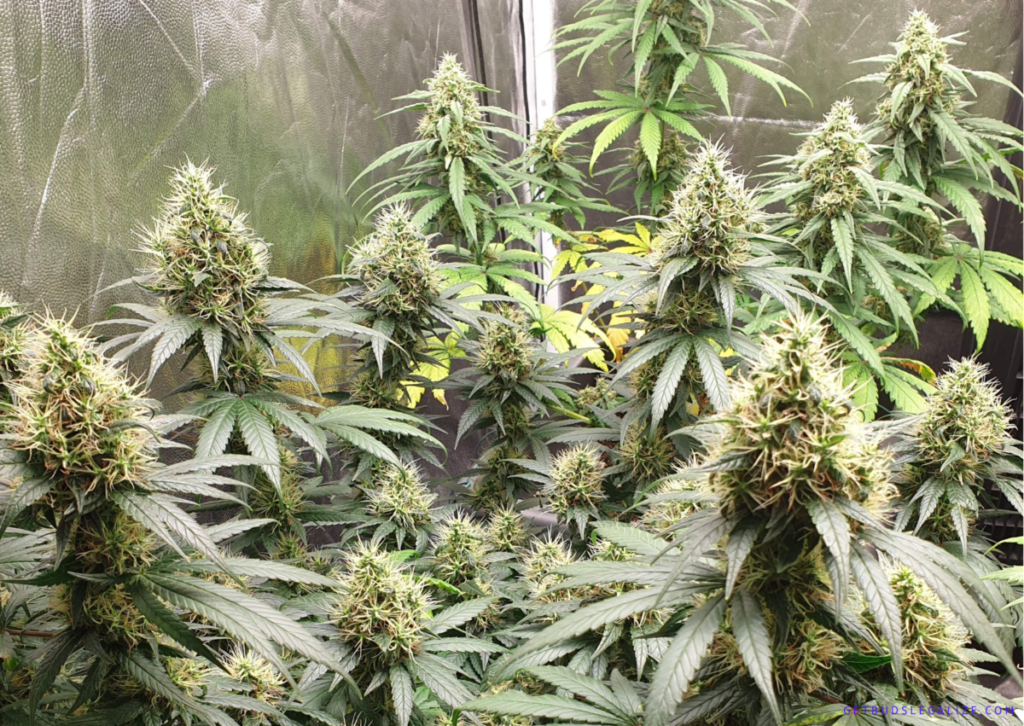
Topping marijuana plants can slightly delay the onset of flowering, as your plant will need some time to recover from the stress and heal the wound. However, this delay is usually negligible and can be compensated by extending the vegetative period or using a faster-flowering strain.
The harvest date of your topped plants will depend on several factors, such as the strain, the environment, and the number of times you top your plants. Generally speaking, topping your plants once or twice will not significantly affect the harvest date, but topping them more than that can prolong the flowering time and delay the harvest.
What Are Some Alternatives to Topping?
Topping is not the only way to train your cannabis plants and increase their yield. There are other methods that you can try, such as:
- Fimming: This is similar to topping, but instead of cutting off the entire stem, you only cut off about 75% of it. This creates four new main branches instead of two.
- LST (Low Stress Training): This involves bending and tying down your branches to create a more horizontal shape and expose more bud sites to light.
- SCROG (Screen of Green): This involves using a net or a screen to spread out your branches and create an even canopy.
- SOG (Sea of Green): This involves growing many small plants in close proximity and harvesting them early before they compete for light and space.
Whatever method you choose, make sure you do it carefully and gently to avoid damaging your plants or stressing them too much. Also, remember that topping and other training techniques are only suitable for photoperiod plants, not autoflowers, as they have a fixed life cycle and cannot recover from stress.
Topping vs Fimming Marijuana Plants
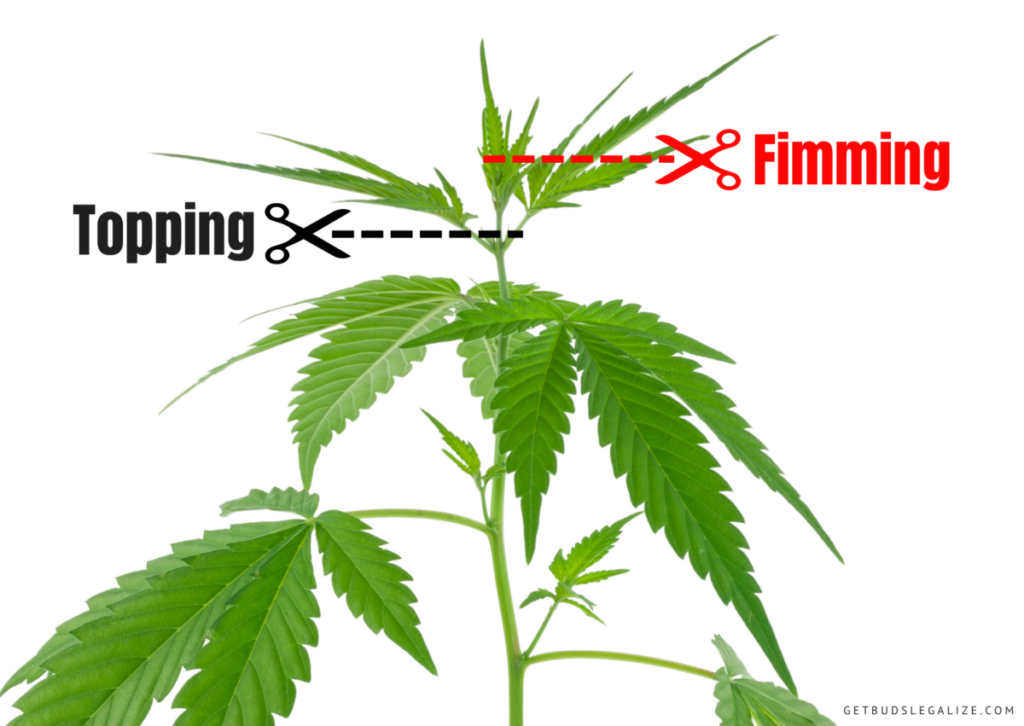
Both methods involve cutting off the top of the main stem to encourage the growth of multiple colas (flowering sites) and create a bushier plant. However, there are some differences between topping and fimming that you should know before deciding which one to use. Here is a comparison of the pros and cons of each method.
Topping Technique:
Topping is a simple and effective way to increase the number of colas on your marijuana plants. To top your plant, you need to cut off the top of the main stem just above a node (where a pair of leaves or branches emerges). This will cause the plant to split into two main stems, each with its own cola. You can repeat this process several times to create more branches and colas, but be careful not to overdo it as it can stress the plant and reduce its overall health.
Pros:
- Creates a more even canopy, which allows for better light penetration and airflow.
- Reduces the height of the plant, which can be useful if you have limited space or want to avoid detection.
- Increases the yield potential of the plant by creating more colas.
Cons:
- Can slow down the growth of the plant for a few days as it recovers from the cut.
- Can make the plant more susceptible to diseases and pests due to the open wound.
- Can reduce the potency of the colas by diverting energy from the main stem to the side branches.
Fimming Technique:
Fimming marijuana is a variation of topping that involves cutting off less of the main stem. To fim your plant, you need to cut off about 75% of the tip of the main stem, leaving behind some leaves. This will cause the plant to produce four or more colas instead of two. Fimming marijuana is less precise than topping and can result in uneven growth.
Pros:
- Creates more colas than topping, which can increase the yield potential of the plant.
- Is less stressful for the plant than topping, as it leaves behind some leaves to help with photosynthesis.
- Is easier to perform than topping, as it does not require a clean cut.
Cons:
- Creates a more uneven canopy, which can reduce light penetration and airflow.
- Can make the plant too bushy, which can cause overcrowding and humidity issues.
- Can reduce the quality of the colas by producing smaller and less dense buds.
Bottom Line
Topping and filming are both useful methods for increasing the yield and shape of your weeds. However, they have different effects on the growth and health of your plants.
Topping creates a more uniform and manageable canopy but can slow growth and reduce potency. Fimming creates more buds and faster growth but can cause patchiness and overcrowding.
The best method for you depends on your personal preferences, growing conditions, and strain. Now all you have to do is try both methods and find out which one works best for you. Happy growing!
Topping Cannabis Plants - FAQS
Topping can be used indoors, but it requires careful timing and attention to avoid stressing the plants or reducing their quality. Topping too early, too late, or too often can stunt the plants or cause them to produce smaller buds. Topping should also be done with clean and sharp scissors to minimize the risk of infection or damage to the plants.
Topping is not recommended for outdoor plants, as it can expose them to harsh weather conditions and pests. Topping can also stress the plants and reduce their vigor. Therefore, it is better to avoid outdoor plants and use other cannabis training methods such as LST or pruning to shape them.
Topping is considered a high-stress technique (HST) because it damages your plants to produce the desired results; therefore, it is not recommended to use during flowering as it can stress the plant and reduce the quality and quantity of buds.
Topping autoflowers is not recommended because it can stress the plants and reduce their growth potential. Autoflowers have a limited vegetative period and need all the energy they can get to produce buds. Topping can also delay the flowering time and affect the quality of the harvest. Therefore, it is better to avoid topping autoflowers and use other methods such as LST or defoliation to improve their structure and airflow.
Topping can increase the yield and quality of cannabis buds by creating a bushier plant with more colas and better light exposure. However, topping is also a high-stress technique that can harm your weed plants if done incorrectly or too often. Therefore, inexperienced cannabis growers should be careful and well-informed before attempting to top their plants.
Topping is a pruning technique that involves cutting off the tip of a branch to encourage lateral growth and increase the yield of a plant. However, topping multiple branches at once can be stressful for the plant and may reduce its overall health and vigor.
Therefore, it is advisable to top only one or two branches at a time and wait for the plant to recover before topping more branches. Topping multiple branches can also affect the shape and structure of the plant, so it is important to plan ahead and choose the branches that will create the desired canopy.
Apical-dominance is the phenomenon where the main stem of a cannabis plant grows faster and taller than the side branches. This is because the apical meristem, located at the end of the main stem, produces a hormone called auxin which inhibits the growth of lateral buds. This phenomenon allows the cannabis plant to compete for sunlight and resources in its natural environment.
ILGM Fertilizer

- From seedling to harvest, give your plants everything they need.
- Enough for feeding at least 5 plants.
- Discounted Package Deal
- Works well in soil, hydroponics, and other growing mediums.
- The best way to treat your plants
ILGM Plant Protector

- Protect your cannabis from diseases and harmful pests.
- Contains three 20 ml bottles.
- Enough supplies to protect 20 plants.
- It can be used in soil, hydroponic, and all other growing mediums.

